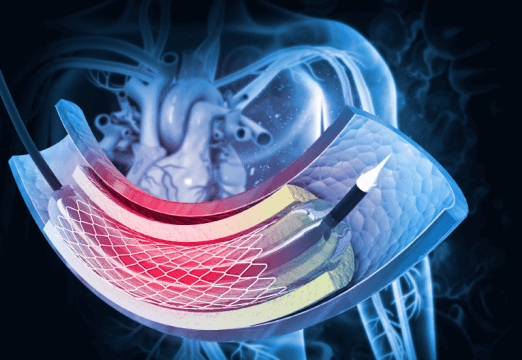The initial strategy for the treatment of patients at high risk of bleeding (HBR) after percutaneous coronary intervention (PCI) has consisted of a short dual antiaggregation therapy (DAPT). Stents continue to improve, which has allowed the reduction of DAPT schemes and therefore the incidence of bleeding.

However, researchers are also looking into another strategy to avoid stenting all together (stentless strategy) and reduce the associated vessel injury. When choosing to go stentless, it is crucial to prepare the target atherosclerotic plaque correctly. At present, there are no assessments comparing predilation techniques for stentless strategies followed by a drug coated balloon.
Perfusion balloons allow prolonged dilation, seeing as they maintain coronary blood flow (defined as coronary driving pressure ≥60 mmHg), achieving adequate diameters with distal flow to prevent ischemia. However, these technique has not been studied with dilation prior to PCI with DCB.
A single-center prospective study called RYUSEI DCB was carried out to assess the safety and efficacy of gradual and prolonged insufflation with perfusion balloon during at least 10 minutes in patients with acute coronary syndrome (ACS) pretreated with aspirin and P2Y12 inhibitor.
It included patients with ACS with native lesion ≤20 mm and 2.0-3.5 reference diameter (assessed by IVUS and OCT). It excluded patients with cardiogenic shock, congestive cardiac failure and malign arrhythmia. All patients were submitted to a coronary computed tomography angiography ((angioCT) at followup to confirm vessel patency before hospital discharge.
Expansion with perfusion balloon RYUSEI was done at 1 atm every 20 seconds until the desired diameter was obtained (balloon-artery ratio 1.0 to 1.1), for 10 minutes followed by a 5-minute interval to assess recoil or dissection, followed by SeQuent paclitaxel DCB. After DCB, one 12,000 UI/d dose of unfractionated heparin was applied during 24 hours. Primary end point was target vessel failure (TVF) at 24 months.
Between April 20, 2019, and October 20, 2019, 30 eligible patients, out of 104 patients who underwent emergency CAG, were assigned to RYUSEI DCB. Mean age was 69 ± 13 years, 80% were men, and 90% were treated for an acute myocardial infarction (AMI). 47% were at high risk of bleeding according to BARC criteria. Mean door-to-balloon time was 41 minutes, the most treated artery was the right coronary and a thrombosis management device was use in 50% of cases.
Read also: CAPTIS, a Novel Cerebral Embolic Protection System in TAVR.
There were no acute occlusions during hospitalization (assessed by angioCT). Immediate stent-free success rate was 80%, with 20% requiring bailout stenting. Ischemia driven revascularization at 2 years was 8%, and with this stentless strategy, there was mean 45-day DAPT duration. OCT assessment showed the presence of ruptured plaque and low calcification scores were predictors of success with stentless PCI.
Conclusions
The stentless strategy with DCB and predilation with perfusion balloon showed promising provisional results at short and mid-term. We should consider it for patients at high risk of bleeding that do not present predictors of bailout stenting on endovascular imaging.

Dr. Omar Tupayachi.
Member of the Editorial Board of SOLACI.org.
Original Title: Novel Stentless Strategy With Perfusion and Drug-Coated Balloons for Treating Acute Coronary Syndrome.
Reference: Ryota Fukuoka, Tomohiro Kawasaki, Kyoko Umeji, Yoshiya Orita, Hisashi Koga, Keisuke Hirai, Kazuki Haraguchi, Yurie Fukami, Kimihiro Kajiyama, Toshiya Soejiyma. Novel Stentless Strategy With Perfusion and Drug-Coated Balloons for Treating Acute Coronary Syndrome. Journal of the Society for Cardiovascular Angiography & Interventions, 2023, 101175, ISSN 2772-9303, https://doi.org/10.1016/j.jscai.2023.101175.
Subscribe to our weekly newsletter
Get the latest scientific articles on interventional cardiology





